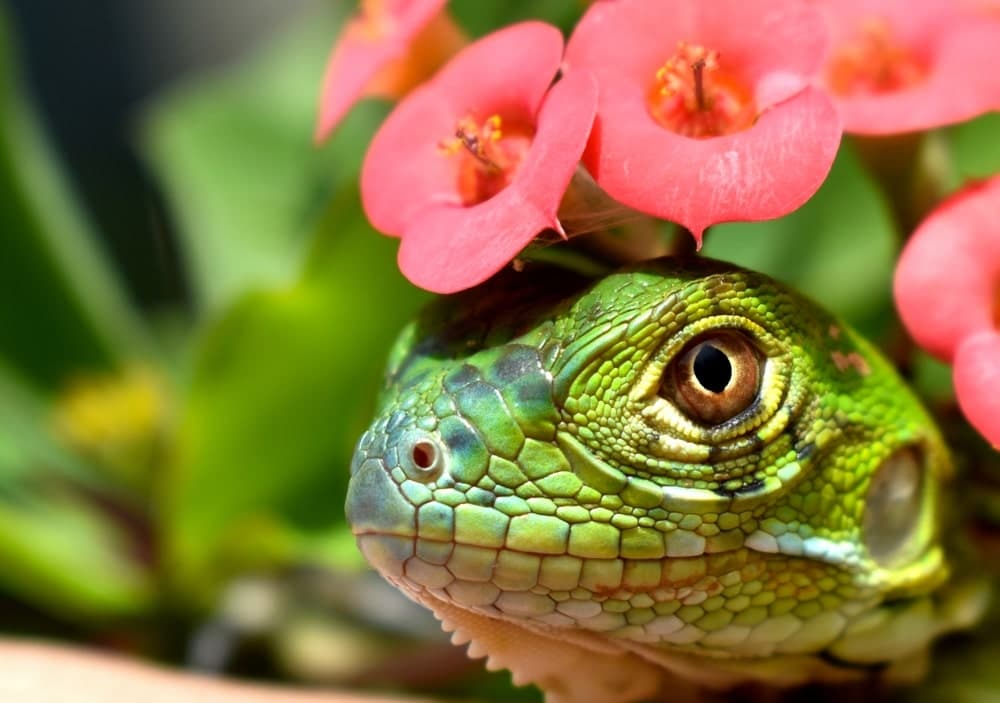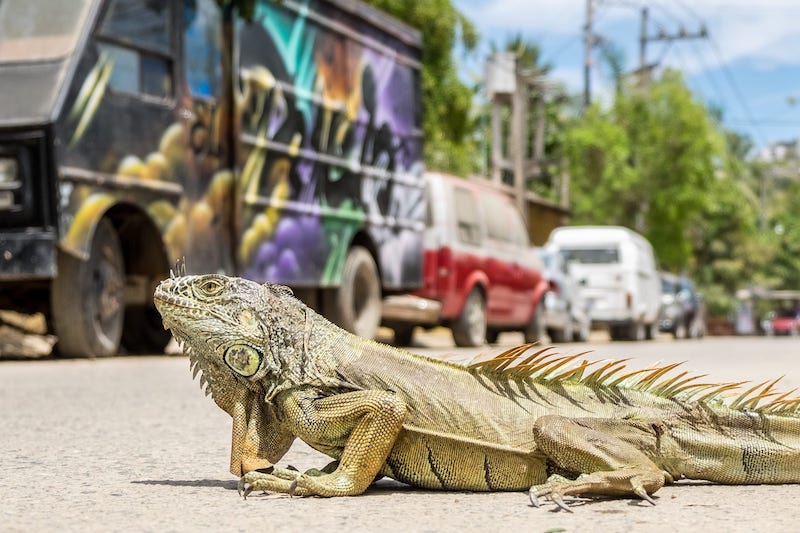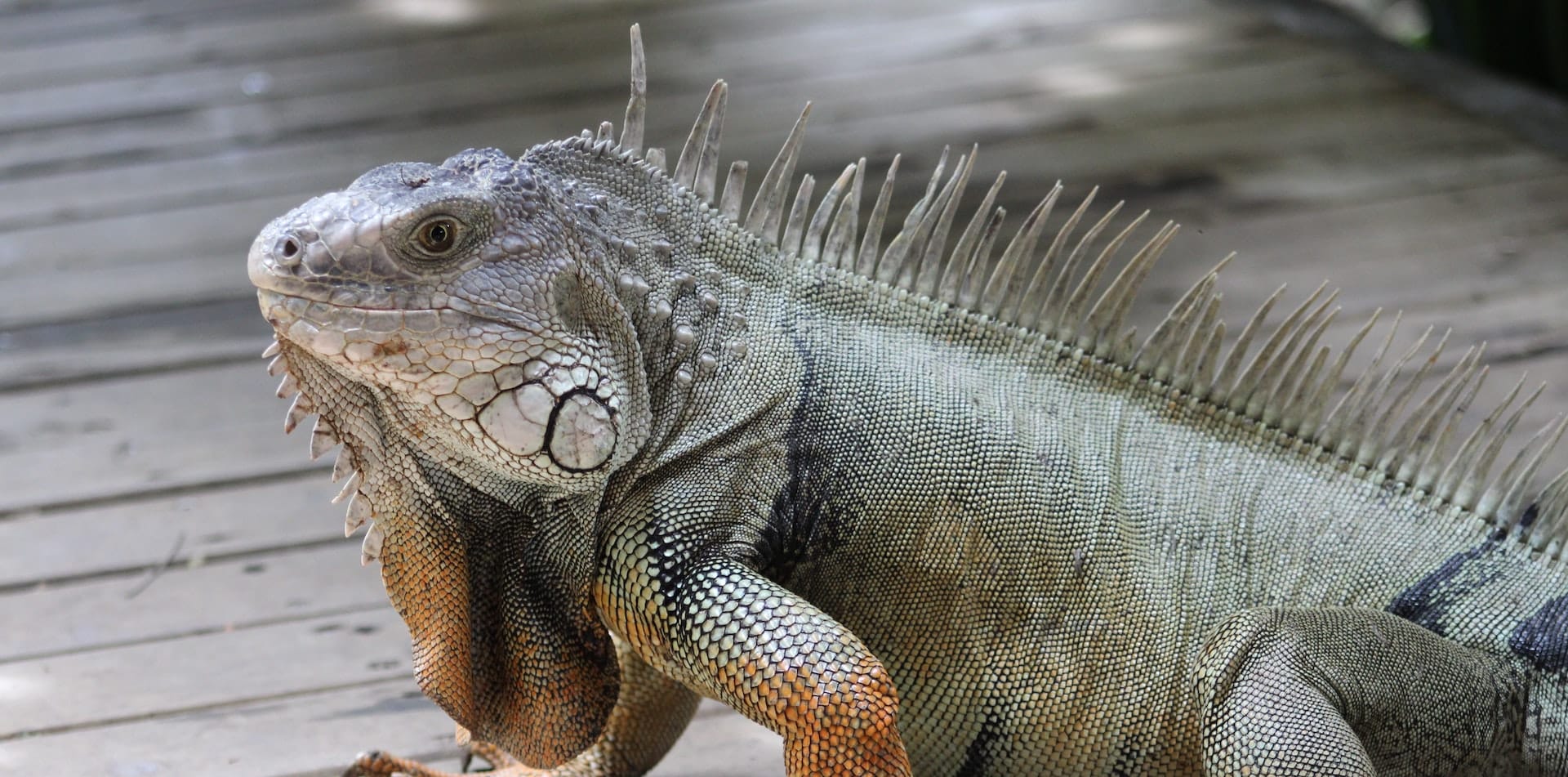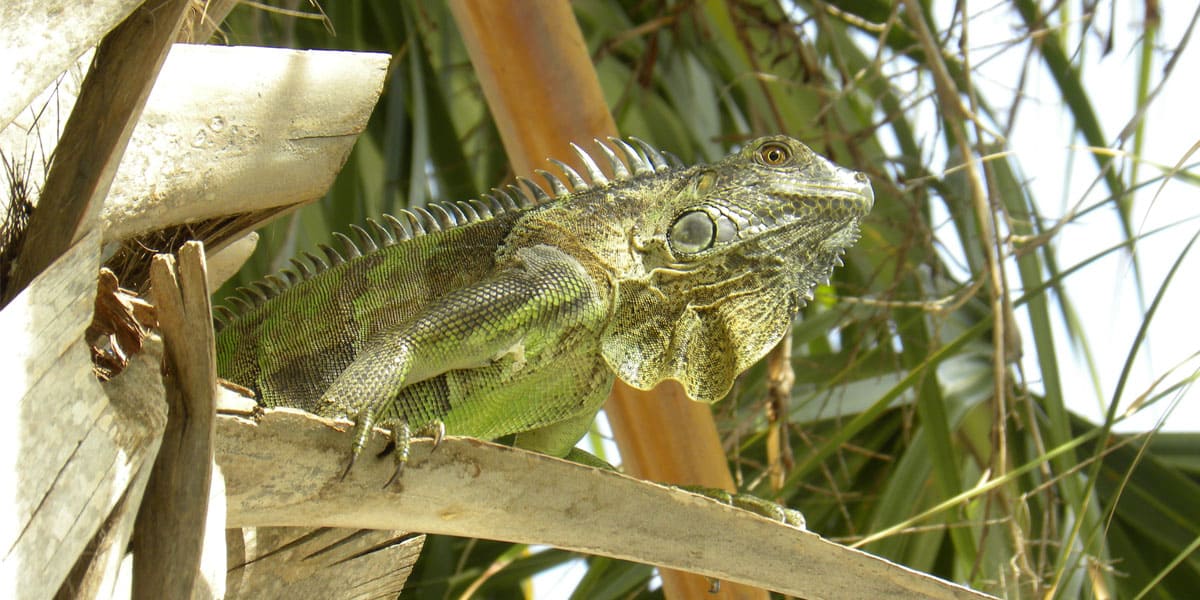Iguanas are reptiles, and they belong to the family Iguanidae. There are over 30 species of iguanas, and they live in various habitats, such as rainforests, deserts, swamps, and islands.
Iguanas are important to the ecosystem because they help keep the plant population in check by eating leaves, flowers, and fruits. They are also a food source for many other animals, such as birds, snakes, and crocodiles. Some iguanas, such as the marine iguana, also help to control the growth of algae on rocks by grazing on them.
Iguanas have many adaptations that help them survive in their environments. For example, they have a row of spines on their back and tail for defense, a flap of skin called a dewlap for temperature regulation and communication, and a third eye on their head for detecting predators. Some iguanas can also change their color to blend in with their surroundings or express their mood.
Sadly, many invasive species of iguanas, such as the green iguana, the orange iguana, the black spiny-tailed iguana, and the Mexican spiny-tailed iguana, other wild iguanas, and other lizards have made their way to the South Florida area, where they are causing problems with residents who find their yards overcome by the presence of these reptiles and who have to deal with their destructive habits on a regular basis, always trying to figure out the best way to accomplish a full iguana control or iguana removal.
If you are dealing with unwanted iguanas on your property, call the iguana removal experts from Iguana Control right away. We will gladly stop by your property and survey the situation. We will then offer you the iguana relief you seek. Depending on what our experts detect in your property, we might recommend topography protection, iguana trapping, spreading iguana repellent, or a continuous iguana monitoring service. Call us today.

What Are Some Threats to Iguanas?
Iguanas are a group of reptiles that live in tropical and subtropical regions of Central and South America and the Caribbean. They include the green iguana, the black spiny-tailed iguana, the Mexican spiny-tailed iguanas, and other adult iguanas. They face many threats to their survival, both from humans and from other animals, such as:
Habitat loss
As human activities destroy or degrade their natural habitats, green iguanas have less space and resources to live in South Florida and nearby islands. This can also affect their breeding and nesting sites, forcing them to emigrate elsewhere to find the proper habitat they need and further damaging other natural areas in the state.
Predation by Invasive Animals
Animals that are not native to the iguanas’ habitats, such as dogs, cats, rats, pigs, and raccoons, can prey on iguanas or their eggs. These animals may also compete with iguanas for shelter or the food iguanas love.
To prevent these reptiles from finding your home attractive, get in the habit of always closing all trash cans tightly, not feeding your pets outdoors, and installing wire mesh around your trees to keep these creatures from climbing and getting to your roof where they can burrow and cause extensive damage to the structure of your home.
Fishing Nets
Iguanas, especially marine iguanas, can get entangled in fishing nets for Florida fish and drown. Fishing nets can also damage the marine ecosystems that iguanas depend on.
If you are a fishing enthusiast, be mindful of your nets and what kind of animals get trapped in them; it is a small gesture that can be beneficial to the environment and the creatures who share it.
Capture for the Pet Trade
Green iguanas, black spiny-tailed iguanas, and Mexican spiny-tailed iguanas are popular pets in some countries, but many are illegally captured from the wild and sold in markets in Western Mexico and Central America. This reduces the wild population of these prolific breeders and exposes juvenile iguanas to stress and disease.
Before agreeing to purchase one of these colorful lizards as a pet for your kids, be mindful of the damaging effects they can have on your lawn, your plants, and your landscaping. What may now look like an interesting and challenging project for your kids may later have you looking for ways in which to get rid of them without harming them or sending them toward your neighbor’s properties.
Poaching
Some people hunt green iguanas for their meat, skin, or eggs. This is illegal in many places but still occurs due to a lack of enforcement or awareness regarding these endangered species.
Climate change
Rising sea levels, temperatures, and extreme weather events can affect the green iguanas’ habitats and food sources. Climate change can also interfere with the green iguanas’ body temperature regulation, egg development, and sex determination in young iguanas.
These threats have caused many introduced species of iguana to become endangered or extinct, according to the Wildlife Conservation Commission. For example, the marine iguana is listed as vulnerable by the IUCN Red List of Threatened Species.
According to wildlife rehabilitators, it is important to protect native species of iguanas and their habitats from these threats for the sake of biodiversity and ecosystem health. By taking small actions in this regard, we can preserve the environment as we know it for all kids and for many generations to come.
How many types of iguanas are in South Florida?
There are three main types of iguanas found in South Florida: the green iguana, the black spiny-tailed iguana, and the Mexican spiny-tailed iguana. None of these species are native to southern Florida, but they have been introduced by humans and have become invasive.
Green iguanas, black spiny-tailed iguanas, and Mexican spiny-tailed iguanas, originally from regions such as Central America, can be found in various habitats throughout the state, including urban areas, along the sea wall, in suburban developments, agricultural lands, and natural areas where they damage native plants. Being opportunistic feeders and prolific breeders, it is not uncommon for these small vertebrates and invasive species to be found in the southern half of the state in great numbers.
What Types of Iguanas are Invasive in Florida?
The type of iguanas that are invasive in Florida are the green iguana, the black spiny-tailed iguana, and the Mexican spiny-tailed iguana. These species are not native to Florida, but they have been introduced by humans and have become a problem for native wildlife and the environment.

How can these iguanas be controlled or removed?
There are different methods for controlling or removing green iguanas from your property, depending on the situation and the local laws. Some of the possible ways are:
Exclusion: This means preventing many species of iguanas or other lizards from accessing your garden or landscape by using fences, screens, barriers, or repellent plants. You can also remove any food sources, such as fruits, vegetables, flowers, or compost piles, that might attract adult iguanas that may get to them with their sharp teeth.
Trapping: This means capturing iguanas using live traps, snares, nets, or poles. You should check the traps regularly and handle the captured iguanas with care, as they can bite or scratch. You should also follow the local regulations for relocating or disposing of the trapped iguanas.
Shooting: This means killing iguanas using firearms or pellet guns. This method should only be used as a last resort, only in cases of perceived danger and with extreme caution, as it can be dangerous and illegal to do so in some areas.
What Are the Largest Iguanas in Florida?
The largest iguanas in Florida are the green iguanas. Adult green iguanas in Florida can grow over 5 feet long and weigh up to 15 pounds when they attain their reproductive maturity. Some of them have reached nearly 7 feet long. They are native to Central and South America, but they have been introduced to Florida by humans and have become a problem for the native wildlife and the environment.
Iguanas are omnivorous creatures, meaning that they will eat both plants and animals. While iguanas typically eat plants and insects, they will also eat small animals, such as mice, if they are available. There have been reports of iguanas eating small mammals, birds, and even other lizards. However, this is not a common occurrence and depends on the availability of food and the opportunity for predation for the iguana population.
What Part of Florida Has the Most Iguanas?
According to the Florida Fish and Wildlife Conservation Commission (FWC), as an invasive species, the green iguana in Florida feeds on a wide variety of vegetation and can cause damage to infrastructure and native wildlife, such as the native burrowing owl. They are considered a nuisance by many residents.
The FWC reports that the green iguana grows most abundantly along the Atlantic Coast in Broward, Martin, Miami-Dade, Monroe, and Palm Beach Counties and along the Gulf Coast in Collier and Lee Counties, where some specimens of the grey-brown basilisk and the yellow belly iguanas have also been spotted.
They have also been sighted as far north as Alachua, Highlands, Hillsborough, Indian River, and St. Lucie Counties. However, they are affected by cold temperatures and may die or become sluggish when the temperature drops below 50°F.
There are two other species of introduced iguanas in Florida that are also invasive in the state: the Mexican spiny-tailed iguana and the black spiny-tailed iguana. These species tend to be more common in the Florida Keys and some parts of Miami-Dade County than the green iguana. They are smaller than green iguanas but more aggressive and territorial, in particular female iguanas.
The FWC offers an iguana removal service for some public lands in South Florida where iguanas pose a threat to human safety or property. They also encourage homeowners to humanely dispose of green iguanas on their own property with landowner permission. However, they advise people to be careful not to harm any native or protected species in their native range, such as the endangered American crocodile or the gopher tortoise.
If you have three iguanas or more that seem to have over-run your property and have filled it with iguana feces that can spread salmonella bacteria, it is best to reach out to the iguana removal experts at Iguana Control to survey the situation and offer you a realistic plan to get rid of all adult iguanas. Schedule an appointment today.
When it comes to trapping iguanas in Florida or other lizards, it is best to do it before the breeding season when your yard can be overrun by baby iguanas since more than 50 eggs can be laid at once, particularly in their own burrows or by your sea walls if your property is by the water.

How Can I Tell the Difference Between Green and Spiny-Tailed Iguanas?
Spiny-tailed and green iguanas are two different types of lizards that belong to different genera. Green iguanas are of the Iguana species and spiny-tailed iguanas are Ctenosaura species
Some of the differences between them are:
- Green iguanas grow much larger than spiny-tailed iguanas. Males can grow to over 6 feet long (including the tail), whereas females can reach just over 5 feet, and the tail accounts for as much as three-quarters of their total length. Spiny-tailed ones can grow to be as small as 4.9 inches long.
- Green lizards have more rounded, stubby heads and spiny-tailed ones have longer, crocodile-like heads.
- A green iguana is perfectly camouflaged when up in the forest canopy, while the spiny tail with its somber markings in black, gray, and brown are far better camouflaged against the parched, dusty soil of the more arid areas of Central America.
- Green lizards are herbivorous and mainly eat foliage and vegetables with some fruit. Spiny-tailed lizards are omnivorous and also eat feeder insects.
- Green iguanas can live for as long as 60 years, depending on the species, whereas spiny-tailed lizards can live for as few as 4 years.
At Iguana Control, we are standing by to serve all of your iguana control and iguana removal needs. Call us today.


